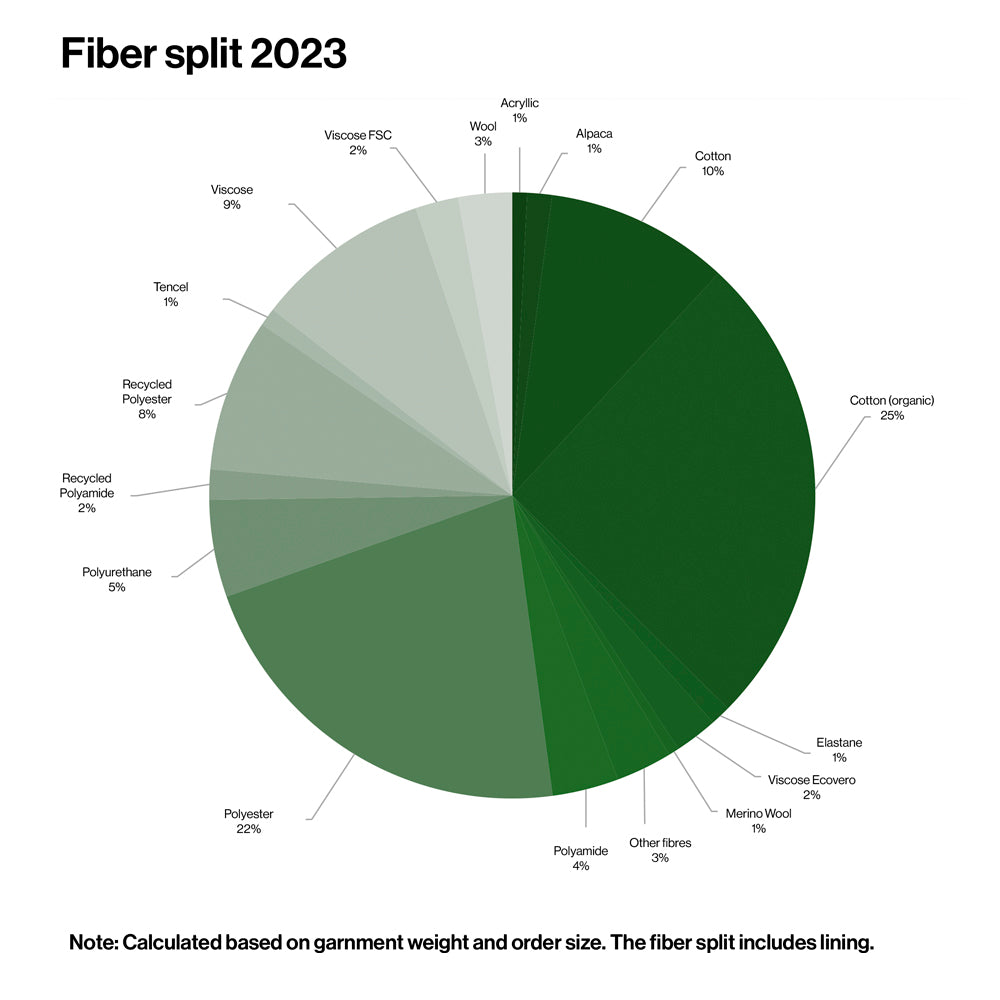Forward-thinking products
Our ultimate goal is longevity and design with a full circle mindset, using materials and processes with the lowest
environmental impact, which can be a part of a closed-loop system - this is our definition of a forward-thinking product. Several components are important in this process: better materials, recyclable products, innovation, improving processes and chemical awareness.
BETTER MATERIALS - COMPLYING WITH SDG # 6, 12 AND 15
Our choice of materials is a crucial factor, when creating forward-thinking products, as it affects up to 50% of our
environmental footprint. When we choose materials, it must complement design and function. Our characterization of a better material can be narrowed down to six C’s:
- Cares for the planet - The environmental footprint of the material is considerably lower than its conventional counterpart.
- Cares for people - The production meets high social standards and working conditions.
- Cares for the animals - The treatment of animals involved is with dignity.
- Compliments form - The material does not require excessive manipulation, additives, and finishing to achieve the desired look.
- Compliments function - The material can withstand the wear and tear expected from the final products use without extraordinary care.
- Compliments longevity - The material is durable and of a high enough quality to withstand several years of use.

We have created our material benchmarking that serves as a tool for our designers and product developers to work systematically in making better material choice.
GOAL: By 2024 we will have phased out 100% of all PVC.
- Favoured materials represent those we define as the sustainable choice.
- Good materials represent those we consider the better choice, when used in moderate amounts.
- Problematic materials represent those that we aim to minimize the use of and replace with good or favoured materials.
- Banned materials represent those that under no circumstances are acceptable in our products.
* Mohair is banned unless from audited farms, complying with the Mohair Industry Sustainable Guidelines
** Further details of our definition of the various Sustainable Cellulose types are outlined in our favoured material description
*** By 2024 we will stop the use of conventional viscose
**** Synthetics including but not limited to polyester, nylon, elastane. Made from pre- or post-consumer waste
Material Benchmarking
Favoured
Cotton Organic & Recycled
Hemp Certified, Organic & Recycled
Linen Certified, Organic & Recycled
Wool Organic, Recycled & RWS
Alpaca
Silk Organic, Recycled & Peace Silk
Down RDS & Recycled
Sustainable Cellulose**
Recycled Synthetics****
Good
Cotton BCI & Pima
Hemp Conventional
Linen Conventional
Cashmere with RWS
Wool Conventional
Merino wool
Leather Vegetable tanned & LWG
Problematic
Cotton Conventional
Silk Conventional
Leather Conventional
Viscose Conventional***
Rayon Conventional
Polyester
Nylon
Acrylic
Lurex & other metal fibres
Elastane
Polyamide
PU
Acetate
Banned
Angora Wool
Mohair*
Down without RDS
Fur
Exotic skins
Viscose
Bamboo
Cupro
Conventional
PVC
RECYCLABLE PRODUCTS – COMPLYING WITH SDG # 6, 12 AND 15
We aim to increase the recyclability of our products significantly and to do this, we prioritise using materials that can be recycled on a commercial scale while avoid using mixed fibres.
GOAL: By 2024 65% of all our products will be recyclable.

INNOVATION
To continuously improve and push towards better solutions, we must stay curious and updated on what is possible. To do this we have committed ourselves to use sustainable innovations as a permanent part of future collections and will incorporate styles made in innovative materials, designed with new methods or sustainable processes.
GOAL: By 2024 we will have 2 innovative programs per collection.
IMPROVING PROCESSES
To decrease our products total impact, we are shifting to better packaging solutions, prioritising cardboard and paper that is certified to guarantee sustainable foresting or with recycled content. Furthermore, we are replacing our hangtags, logo and care labels with ones made of recycled materials.
We set high standards for our product trimmings in terms of both quality and safety. For these parts, durability is a crucial priority as the loss a single button can mean the disposal of the whole product. By 2024, we require that all metal and plastic trimmings, such as zippers, buttons and adjusters are Oeko-tex® Standard 100 certified as a
minimum. We are shifting to green energy suppliers at our own offices and stores, and implement comprehensive sorting systems to ensure that we handle our waste in a responsible matter.
GOAL: By 2022 50% of our hangtags and labeling will be certified paper, recycled or organic approved, reaching 100% in 2024.
CHEMICALS
Our use of chemical must never be at the risk of harming our environment or the people in contact with our products. We are working under the chemical restrictions set by the European Union known as REACH. REACH is a regulation that ensures that products imported to Europe live up strict requirements and limits, and all of our products comply with this as a minimum. In the coming years, our suppliers will be required to comply with the chemical restrictions set by Oeko-tex® Standard 100 as a minimum.
Read more about our chemical handling and restrictions in our Chemical Policy.